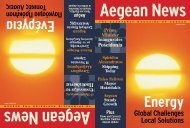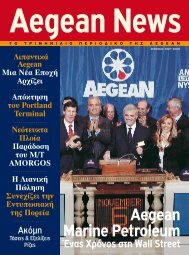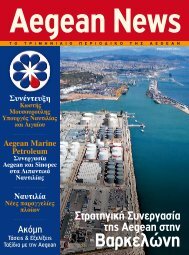Download Magazine in PDF form - aegean marine petroleum ...
Download Magazine in PDF form - aegean marine petroleum ...
Download Magazine in PDF form - aegean marine petroleum ...
You also want an ePaper? Increase the reach of your titles
YUMPU automatically turns print PDFs into web optimized ePapers that Google loves.
standard that are drawn from the accumulatednew construction and <strong>in</strong>-serviceexperience of each of the three societies.Throughout their development,the new Rules have been discussed withan external review group that <strong>in</strong>cludesshipbuilders, shipowners, designers, and<strong>in</strong>dependent consultants.Classification societies actually worktogether with shipowners—not just aspure regulators. They work closely withshipowners’ associations to <strong>form</strong>ulateregulations for the future and also to devisepractical methods of survey and auditof statutory regulations.The shipp<strong>in</strong>g <strong>in</strong>dustry is made up ofa number of different regulators. Sometimes,conservatism is necessary <strong>in</strong> orderto ensure that higher safety standardsare cont<strong>in</strong>ually promoted, as overflexibilitywith<strong>in</strong> the system can lead toan unwanted erosion of standards. The<strong>in</strong>dustry has to react to major <strong>in</strong>cidentsand any perceived reluctance to changeresults from its desire to ma<strong>in</strong>ta<strong>in</strong> standardsrather than any opposition toprogress. It should be noted that classificationsocieties can, and do, <strong>in</strong>troducechanges very rapidly—far more so thanthe other bodies <strong>in</strong>volved with safetystandards at sea.Involvement <strong>in</strong> the tanker bus<strong>in</strong>essrequires balanc<strong>in</strong>g a number of differentfactors to achieve the overall objectiveof a successful bus<strong>in</strong>ess. These <strong>in</strong>cludenot only safety, but commercial,per<strong>form</strong>ance, operational, environmental,and organisational issues as well.When a risk assessment for safety is carriedout, all of these issues can be <strong>in</strong>cluded<strong>in</strong> the evaluation. Hence, safetycan be achieved without compromis<strong>in</strong>gother bus<strong>in</strong>ess objectives.Lloyd’s Register helps owners and operatorsto understand how they can meetthe challenges of TMSA. We providemany services that can help ownersdemonstrate compliance with the TM-SA guide:● management systems (ISO, ISM,ISPS, EMS, OHSAS)● gap analysis, prelim<strong>in</strong>ary andperiodical assessments● risk assessment services● operational risk assessment software- Lloyd’s Register Mar<strong>in</strong>er● ship emergency response service(SERS)● fuel oil bunker analysis services(FOBAS)● planned ma<strong>in</strong>tenance and conditionmonitor<strong>in</strong>g schemes● ballast water management plann<strong>in</strong>g● ClassDirect Live● human element studies● tra<strong>in</strong><strong>in</strong>g needs assessments and arange of practical coursesThe mar<strong>in</strong>e world has well-establishedmethods of work<strong>in</strong>g, generallybased around a prescriptive approach.However there are many new techniquesand tools com<strong>in</strong>g <strong>in</strong>to the sectorthat are based upon risk methods. Ifcompanies take the time to look at theserisk-based approaches they will be ableto see that their bus<strong>in</strong>ess operates as as<strong>in</strong>gle <strong>in</strong>tegrated unit with safety result<strong>in</strong>gfrom comb<strong>in</strong>ations of a large rangeof factors. Issues relat<strong>in</strong>g to design, tra<strong>in</strong><strong>in</strong>g,operation, and culture can be evaluatedand understood <strong>in</strong> the context ofhow they <strong>in</strong>fluence safety under differentcircumstances.This understand<strong>in</strong>g can then be fedback <strong>in</strong>to both risk-based and prescriptiverule mak<strong>in</strong>g. However, the greatestdriver from risk-based techniques willbe the appreciation that every scenario isdifferent and requires an understand<strong>in</strong>gof the situation at hand, and not prewrittenRules, to ensure a safe outcome.S<strong>in</strong>ce the <strong>in</strong>troduction of the ISMCode, the safety culture with<strong>in</strong> the maritime<strong>in</strong>dustry has undoubtedly improved.Safety is very much <strong>in</strong> the <strong>in</strong>terestof all stakeholders, <strong>in</strong>clud<strong>in</strong>g owners,shipmanagers, ship crews, and class, anda holistic approach is highly desirable.Class shares the ISM Code’s aim ofimprov<strong>in</strong>g safety at sea, and a close relationshipbetween the two is essential<strong>in</strong> order to achieve this.People make a difference, and it is nowbecom<strong>in</strong>g more widely accepted that thehuman element is important to maritimesafety. This has been understood <strong>form</strong>any years, but there now seems to be agreater will<strong>in</strong>gness to consider how toreduce the impact and to reduce thenumber of <strong>in</strong>cidents that result from thefail<strong>in</strong>gs of people. Lloyd's Register is <strong>in</strong>vest<strong>in</strong>g<strong>in</strong> creat<strong>in</strong>g greater awareness and<strong>in</strong> develop<strong>in</strong>g methodologies for tackl<strong>in</strong>ghuman system <strong>in</strong>teraction <strong>in</strong> a constructiveand beneficial way. The focusPeople make a difference, and it is now becom<strong>in</strong>g morewidely accepted that the human element is importantto maritime safety.has to move away from the bridge andthe widely held belief that the human elementis synonymous with watch-keep<strong>in</strong>gand to work towards a genu<strong>in</strong>ely human-centreddesign for ships that encouragesen effective relationship betweenpeople and hardware. Throughthis approach an improvement <strong>in</strong> maritimesafety is achievable.To conclude however, it must be emphasisedthat <strong>in</strong> order to achieve this improvementit is important that all thema<strong>in</strong> stakeholders, such as IMO, EU, theShipowners’ Associations, the Shipbuilders’Associations and Class, workmore closely together to br<strong>in</strong>g technicaland operational experience to bear oncurrent and future regulations.SUMMER 2005 AEGEAN NEWS 23
















